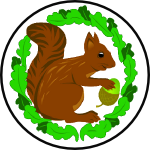Forest School
We use the beautiful environment that surrounds the school as much as possible to extend our learning outside the classroom. We started Forest School back in 2010 and have a trained Forest School Leader within our staff.
The Forest School concept originated in Scandinavia and arrived in Britain back in 1995. Children learn through exploration and experimentation. The quality of learning is enhanced by interested and motivated adults supporting and extending the children’s interests. Being in an outdoor environment requires creative and wider thinking that does not simply transfer the indoors to the outdoors. A holistic approach to the delivery of the curriculum, with the emphasis on personalised learning in an environment that is not resource driven, is facilitated. The children learn to use tools, build structures, manage risk, and investigating wild life as well as using the rich source of experience in their classroom.
Education such as this, has huge implications for the attitudes, health and wellbeing of our young people. We need to encourage empathy and understanding of the natural world. Forest School does this as well as delivering a vast amount of rich learning, deep, crucial thinking and above all enjoyment.
Forest school
Forest School sessions will be on Tuesday afternoons. .
What is forest school?
Forest school is an inspirational process that helps and offers ALL learners regular opportunities to achieve and develop confidence and self-esteem through hands on learning experiences in a natural environment with trees.
At Forest School all participants are viewed as:
Equal, unique and valuable
Competent to explore and discover
Entitled to experience appropriate risk and challenges
Entitled to choose and to initiate as well as drive their own learning and development
Entitled to experience regular success
Entitled to develop positive relationships with themselves and others
Entitled to develop a strong, positive relationship with their natural world
During our Forest School sessions the children will have the opportunity to explore the outdoors area whilst challenging themselves with different activities which include:
tree climbing, team building, tool use and den building, in addition to learning about the outdoor area as well as, how to protect and look after our environment. This allows the children to take appropriate risks in a safe and natural environment.
How children are kept safe?
At each session there is always a Forest School leader (Miss Bardell) who is trained in first aid. There are also 2 additional members of staff that will accompany the class. A mobile phone enables contact to be made quickly with the main school. The school’s accident and emergency procedures will be followed at all times.
Children are shown the boundaries of the outdoor learning space and are given the chance to look at self-risk benefits alongside risk assessments carried out by the Leader and Staff attending Forest school.
How can you help?
Children should have clothing appropriate to the weather, long trousers and sleeves are suggested to keep skin covered. (Old clothing is better) Children can come to school in their Forest School clothes. Wellies can be kept in school, rather than bringing them in each week. If you are available to help out during any of the forest school sessions please put your preferred dates on the reply slip at the bottom of this letter.
Cancellation
Forest School will only be cancelled in extreme weather if the site is deemed unsafe or if there are not enough adults to accompany the children.
Behaviour
Behaviour will be dealt with in line with the schools School Behaviour Policy. However, we reserve the right to exclude a child from attending Forest School if their behaviour is dangerous to themselves or anyone in Forest School.
Why is Forest School such a great opportunity for your children?
- Research has shown that learning that takes place in the outdoors is much more powerful and memorable as all the senses are involved.
- Forest Schools develop children through a child led approach.
- Children are taught how to assess risks for themselves.
- Children are able to develop their speech, language, social skills and empathy.
- They learn to respect and appreciate the natural environment.
What will they do there?
Children will gradually build up to different activities as trust is gained. These may include:
Mud painting
Shelter building
Collecting wood
Using basic tools under supervision.
Using a talking stick for listening and talking to each other at basecamp.
Team building
Tree climbing
Clothing
Welly boots or sturdy shoes – not school shoes please.
Waterproof outer clothing – trousers and coat
Warm clothing to put under water proofs – long sleeves and trousers
